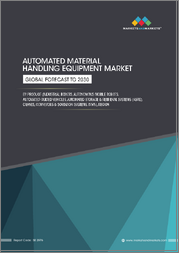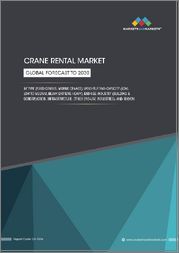
|
시장보고서
상품코드
1576468
크레인 시장 규모, 점유율, 예측, 동향 분석 : 유형별, 등급별, 리프팅 메커니즘별, 제어 방법별, 최종 사용 산업별 - 세계 예측(-2031년)Cranes Market Size, Share, Forecast, & Trends Analysis by Type, Class, Lifting Mechanism, Control Method, and End-use Industry - Global Forecast to 2031 |
||||||
이 보고서는 "크레인 시장 : 유형별(타워 크레인, 이동식 크레인, 오버 헤드 크레인), 클래스별(클래스 A {대기 서비스}, 클래스 B {라이트 서비스}, 클래스 C), 리프팅 메커니즘별, 제어 방법별, 최종 이용 산업별(건설, 석유 및 가스), 지역별 - 세계 예측(-2031년)"이라는 제목의 이 보고서는 5개 주요 지역의 세계 크레인 시장을 상세히 분석하여 현재 시장 동향, 시장 규모, 시장 점유율, 최근 동향 및 2031년까지의 예측에 중점을 두고 있습니다.
세계 크레인 시장은 2024년부터 2031년까지 4.6%의 CAGR로 2031년까지 517억 달러에 달할 것으로 예상됩니다.
크레인 시장 성장의 원동력은 급속한 도시화 및 인프라 구축, 세계 무역의 확대와 이에 따른 항만 및 조선소 작업의 증가, 크레인 기술의 발전입니다. 그러나 크레인의 높은 초기 투자 요건과 높은 운영 비용은 이 시장의 성장을 저해하는 요인으로 작용하고 있습니다.
또한, 스마트 시티 인프라 프로젝트의 성장과 재생에너지 수요 증가는 이 시장의 이해관계자들에게 큰 성장 기회를 제공할 것으로 예상됩니다. 그러나 숙련된 운영자의 부족은 시장 성장에 영향을 미치는 큰 도전이 되고 있습니다.
목차
제1장 소개
제2장 조사 방법
제3장 주요 요약
- 개요
- 시장 분석 : 유형별
- 시장 분석 : 클래스별
- 시장 분석 : 리프팅 기구별
- 시장 분석 : 제어 방법별
- 시장 분석 : 최종 이용 산업별
- 시장 분석 : 지역별
- 경쟁 분석
제4장 시장 인사이트
- 개요
- 시장 성장에 영향을 미치는 요인
- 성장 촉진요인
- 급속한 도시화와 인프라 정비
- 세계 무역 확대와 그에 따른 항만·조선소 업무 증가
- 크레인 기술의 진보
- 성장 억제요인
- 크레인 높은 투자 요건과 운영 비용
- 기회
- 스마트 시티·인프라 프로젝트 성장
- 재생에너지 수요 증가
- 과제
- 숙련 오퍼레이터의 부족
- 성장 촉진요인
- 사례 연구
- 밸류체인 분석
- Porter's Five Forces 분석
제5장 세계의 크레인 시장 : 유형별
- 개요
- 타워 크레인
- 이동식 크레인
- 천장 크레인
- 신축식 크레인
- 크롤러 크레인
- 철도 크레인
- 플로팅 크레인
- 공중 크레인
- 지브 크레인
- 갠트리 크레인
- 기타 크레인 유형
제6장 세계의 크레인 시장 : 클래스별
- 개요
- 클래스 A(스탠바이 또는 부정기 서비스)
- 클래스 B(라이트 서비스)
- 클래스 C(중규모 서비스)
- 클래스 D(헤비 서비스)
- 클래스 E(극한 서비스)
- 클래스 F(연속 극한 서비스)
제7장 세계의 크레인 시장 : 리프팅 기구별
- 개요
- 유압 크레인
- 전동 크레인
- 디젤 크레인
- 기타 리프팅 기구별
제8장 세계의 크레인 시장 : 제어 방식별
- 개요
- 수동 크레인
- 원격 조작 크레인
- 자동 크레인
제9장 세계의 크레인 시장 : 최종 이용 산업별
- 개요
- 건설
- 항만·해운
- 석유 및 가스
- 항공우주 및 방위
- 기타 최종 이용 산업
제10장 크레인 시장 : 지역별
- 북미
- 미국
- 캐나다
- 유럽
- 독일
- 영국
- 프랑스
- 이탈리아
- 스페인
- 네덜란드
- 스위스
- 스웨덴
- 덴마크
- 기타 유럽
- 아시아태평양
- 중국
- 일본
- 인도
- 한국
- 호주·뉴질랜드
- 인도네시아
- 태국
- 베트남
- 말레이시아
- 싱가포르
- 기타 아시아태평양
- 라틴아메리카
- 멕시코
- 브라질
- 기타 라틴아메리카
- 중동 및 아프리카
- 아랍에미리트
- 이스라엘
- 기타 중동 및 아프리카
제11장 세계의 크레인 시장 : 경쟁 상황
- 개요
- 주요 성장 전략
- 시장 차별화 요인
- 시너지 분석 : 주요 거래와 전략적 제휴
- 경쟁 대시보드
- 업계 리더
- 차별화 요인
- 선두 기업
- 현대 유력 기업
- 벤더 시장 포지셔닝
- 시장 점유율 분석
제12장 기업 개요(기업 개요, 재무 개요, 제품 포트폴리오, 전략적 전개, SWOT 분석*)
- Liebherr Group
- Terex Corporation
- Tadano Ltd.
- Caterpillar Inc.
- Gorbel Inc.
- Konecranes Plc
- The Manitowoc Company, Inc.
- XCMG Group
- Zoomlion Heavy Industry Science and Technology Co., Ltd.
- SANY Heavy Industry Co., Ltd.
- Pelloby Ltd.
- Demag Cranes & Components GmbH
- Street Crane Company Limited
- Hitachi Construction Machinery Europe NV
- Komatsu Ltd.
(참고 : 상위 5개사 SWOT 분석을 제공합니다)
제13장 부록
ksm 24.11.20Cranes Market by Type (Tower Cranes, Mobile Cranes, Overhead Cranes), Class (Class A {Standby Service}, Class B {Light Service}, Class C), Lifting Mechanism, Control Method, End-use Industry (Construction, Oil & Gas), and Geography-Global Forecast to 2031.
The research report titled 'Cranes Market by Type (Tower Cranes, Mobile Cranes, Overhead Cranes), Class (Class A {Standby Service}, Class B {Light Service}, Class C), Lifting Mechanism, Control Method, End-use Industry (Construction, Oil & Gas), and Geography-Global Forecast to 2031' provides an in-depth analysis of global cranes market across five major geographies and emphasizes on the current market trends, market sizes, market shares, recent developments, and forecasts till 2031.
The global cranes market is projected to reach $51.7 billion by 2031, at a CAGR of 4.6% from 2024 to 2031.
The growth of the cranes market is driven by rapid urbanization and infrastructure development, growing global trade & the consequent increase in port and shipyard operations, and advancements in crane technology. However, the high initial investment requirements and operational costs of cranes restrain the growth of this market.
Furthermore, growth in smart city & infrastructure projects and the rising demand for renewable energy are expected to generate significant growth opportunities for the stakeholders in this market. However, the lack of skilled operators is a major challenge impacting the market's growth.
The cranes market is segmented by type (tower cranes, mobile cranes, overhead cranes, telescopic cranes, crawler cranes, railroad cranes, floating cranes, aerial cranes, jib cranes, gantry cranes, and other crane types), class (class A {standby or infrequent service}, class B {light service}, class C {moderate service}, class D {heavy service}, class E {severe service}, and class F {continuous severe service}), lifting mechanism (hydraulic cranes, electric cranes, diesel cranes, and other lifting mechanisms), control method (manual cranes, remote-controlled cranes, and automated cranes), and end-use industry (construction, ports & shipping, oil & gas, aerospace & defense, and other end-use industries). The study also evaluates industry competitors and analyzes the market at the regional and country levels.
Based on type, the cranes market is segmented into tower cranes, mobile cranes, overhead cranes, telescopic cranes, crawler cranes, railroad cranes, floating cranes, aerial cranes, jib cranes, gantry cranes, and other crane types. In 2024, the tower cranes segment is expected to account for the largest share of 22.0% of the cranes market. This segment's significant market share can be attributed to the various benefits of tower cranes. They are incredibly versatile and can handle heavy lifting tasks at construction sites, such as lifting steel, concrete, and other materials to great heights. Their efficiency in various construction projects, including high-rise buildings and infrastructure projects, makes them indispensable in the construction industry. Also, advancements in technology have led to the development of tower cranes with features such as increased lifting capacities, improved safety systems, and better energy efficiency. These technological innovations drive the adoption of tower cranes among construction companies looking to optimize their operations.
Furthermore, various key market players are launching advanced tower cranes. For instance, in January 2024, The Manitowoc Company, Inc. (U.S.) announced the launch of the Potain MCT 1005 M50, the largest topless tower crane manufactured at its Zhangjiagang facility in China. Also, in October 2022, KenzFigee (Netherlands) launched its first up-tower crane solution for offshore wind.
However, the mobile cranes segment is projected to register the highest CAGR during the forecast period. The growth of this segment is driven by the benefits of mobile cranes. These cranes are highly versatile and can be easily transported between sites. Their mobility allows them to access a wide range of locations, making them suitable for various applications such as construction, infrastructure development, industrial projects, and disaster response. Also, mobile cranes offer high efficiency in lifting and moving heavy loads. They are equipped with telescopic booms or hydraulic arms that provide significant reach and lifting capacity, enabling them to handle a wide range of tasks with precision and speed.
Based on class, the cranes market is segmented into class A, class B, class C, class D, class E, and class F. In 2024, the class D segment is expected to account for the largest share of the cranes market. This segment's significant market share can be attributed to the benefits of class D (heavy service) cranes. These cranes are designed to lift and move substantial loads in a variety of industries, including construction, manufacturing, mining, and oil & gas. Their versatility allows them to be used in diverse applications, making them indispensable in various end-use industries.
Additionally, the class D segment is projected to register the highest CAGR during the forecast period.
Based on lifting mechanism, the cranes market is segmented into hydraulic cranes, electric cranes, diesel cranes, and other lifting mechanisms. In 2024, the hydraulic cranes segment is expected to account for the largest share of 44.0% of the cranes market. This segment's significant market share can be attributed to the benefits of hydraulic cranes. These cranes are efficient and offer versatility in terms of lifting capacity and maneuverability. Hydraulic cranes are relatively easier to operate compared to some other types of cranes. They often feature intuitive controls and ergonomic designs, reducing the time required for training operators. This ease of operation increases the accessibility of hydraulic cranes for a broader range of users, further driving their demand in the market.
However, the electric cranes segment is projected to register the highest CAGR during the forecast period. The growth of this segment is driven by the benefits of electric cranes. These cranes produce zero emissions during operation, making construction and other industries more sustainable. Electric cranes typically feature advanced safety systems and precise control mechanisms, enhancing overall safety for operators and bystanders. With fewer moving parts and simplified maintenance requirements compared to diesel-powered cranes, electric cranes offer increased reliability and uptime, contributing to higher productivity on job sites.
Based on control method, the cranes market is segmented into manual cranes, remote-controlled cranes, and automated cranes. In 2024, the manual cranes segment is expected to account for the largest share of ~33.0% of the cranes market. This segment's significant market share can be attributed to the better affordability and lower maintenance costs of manual cranes compared to automated cranes. Manual cranes have fewer components and less sophisticated technologies, resulting in lower initial investment requirements. Manual cranes can be easily maneuvered and adapted to different tasks and environments. Their flexibility allows them to handle a wide range of loads, making them suitable for various industries such as construction, manufacturing, and shipping.
However, the automated cranes segment is projected to register the highest CAGR during the forecast period. The growth of this segment is driven by the benefits of automated cranes. These cranes can perform repetitive tasks with high precision and consistency, leading to improved efficiency in material handling operations. They can operate continuously without fatigue, resulting in higher productivity and throughput. Automated cranes reduce the need for manual labor in material handling tasks. By automating repetitive and physically demanding tasks, they allow human workers to focus on more complex or value-added activities, ultimately reducing labor costs. Furthermore, automated cranes are increasingly being implemented at ports around the world. For instance, in November 2024, the Port of Colombo (POC) implemented ABB's (Switzerland) automated stacking cranes to enhance the operational efficiency of its new larger terminals.
Based on end-use industry, the cranes market is segmented into construction, ports & shipping, oil & gas, aerospace & defense, and other end-use industries. In 2024, the construction segment is expected to account for the largest share of 35.0% of the cranes market. This segment's significant market share can be attributed to the wide use of cranes at construction sites. Cranes significantly enhance productivity at construction sites by streamlining material handling processes. They can lift and transport materials to various locations within the site quickly, reducing manual labor requirements and accelerating construction timelines.
Furthermore, the key players in the cranes market are focused on developing advanced cranes for construction applications. For instance, in October 2024, Potain (France) launched a brand-new self-erecting crane, the Potain Evy 30-23 4 t. It is the first model from the new Evy range of self-erecting tower cranes and is designed for home construction and residential building construction up to three stories in height. Also, in February 2024, Action Construction Equipment (India) introduced several products at the Bauma Conexpo 2024, including India's first fully electric mobile crane, the country's most substantial indigenous crane capable of lifting 180 tons, and India's inaugural self-propelled aerial work platforms.
Additionally, the construction segment is projected to register the highest CAGR during the forecast period.
Based on geography, the cranes market is segmented into North America, Europe, Asia-Pacific, Latin America, and the Middle East & Africa. In 2024, Asia-Pacific is expected to account for the largest share of 46.0% of the cranes market. Asia-Pacific's large market share can be attributed to the region's accelerated infrastructure development and major investments in the transportation, energy, and construction sectors. These factors have boosted the demand for larger, more specialized cranes in the region. Cranes are widely utilized in the region's manufacturing facilities for material handling, assembly, and logistics.
The adoption of advanced crane technologies such as automation, remote monitoring, and IoT-enabled systems is increasing in the Asia-Pacific region. These technologies enhance the operational efficiency, safety, and productivity of cranes. Also, the Asia-Pacific region is witnessing significant growth in renewable energy projects, including wind farms and solar parks. Cranes are used in the installation and maintenance of renewable energy infrastructure.
Additionally, the Asia-Pacific region is projected to register the highest CAGR of ~6.0% during the forecast period.
The key players operating in the cranes market include Liebherr Group (Switzerland), Terex Corporation (U.S.), Tadano Ltd. (Japan), Caterpillar Inc. (U.S.), Gorbel Inc. (U.S.), Konecranes Plc (Finland), The Manitowoc Company, Inc. (U.S.), XCMG Group (China), Zoomlion Heavy Industry Science and Technology Co., Ltd. (China), SANY Heavy Industry Co., Ltd. (China), Pelloby Ltd. (U.K.), Demag Cranes & Components GmbH (Germany), Street Crane Company Limited (U.K.), Hitachi Construction Machinery Europe NV (Netherlands), and Komatsu Ltd. (Japan).
Key Questions Answered in the Report:
- What are the high-growth market segments in terms of type, class, lifting mechanism, control method, and end-use industry?
- What is the historical market size for the global cranes market?
- What are the market forecasts and estimates for 2024-2031?
- What are the major drivers, restraints, opportunities, challenges, and trends in the global cranes market?
- Who are the major players in the global cranes market, and what are their market shares?
- What is the competitive landscape like?
- What are the recent developments in the global cranes market?
- What are the different strategies adopted by major market players?
- What are the trends and high-growth countries?
- Who are the emerging players in the global cranes market, and how do they compete with the other players?
Scope of the Report:
Cranes Market Assessment-by Type
- Tower Cranes
- Mobile Cranes
- Overhead Cranes
- Telescopic Cranes
- Crawler Cranes
- Railroad Cranes
- Floating Cranes
- Aerial Cranes
- Jib Cranes
- Gantry Cranes
- Other Crane Types
Cranes Market Assessment-by Class
- Class A (Standby or Infrequent Service)
- Class B (Light Service)
- Class C (Moderate Service)
- Class D (Heavy Service)
- Class E (Severe Service)
- Class F (Continuous Severe Service)
Cranes Market Assessment-by Lifting Mechanism
- Hydraulic Cranes
- Electric Cranes
- Diesel Cranes
- Other Lifting Mechanisms
Cranes Market Assessment-by Control Method
- Manual Cranes
- Remote-controlled Cranes
- Automated Cranes
Cranes Market Assessment-by End-use Industry
- Construction
- Ports & Shipping
- Oil & Gas
- Aerospace & Defense
- Other End-use Industries
Cranes Market Assessment-by Geography
- North America
- U.S.
- Canada
- Europe
- Germany
- U.K.
- France
- Italy
- Spain
- Netherlands
- Switzerland
- Sweden
- Denmark
- Rest of Europe
- Asia-Pacific
- China
- Japan
- India
- South Korea
- Australia & New Zealand
- Indonesia
- Thailand
- Vietnam
- Malaysia
- Singapore
- Rest of Asia- Pacific
- Latin America
- Mexico
- Brazil
- Rest of Latin America
- Middle East & Africa
- UAE
- Israel
- Rest of the Middle East & Africa
TABLE OF CONTENTS
1. Introduction
- 1.1 Market Definition & Scope
- 1.2 Currency & Limitations
- 1.2.1 Currency
- 1.2.2 Limitations
2. Research Methodology
- 2.1 Research Approach
- 2.2 Data Collection & Validation Process
- 2.2.1 Secondary Research
- 2.2.2 Primary Research/Interviews with Key Opinion Leaders from the Industry
- 2.3 Market Sizing & Forecasting
- 2.3.1 Market Size Estimation Approach
- 2.3.2 Growth Forecast Approach
- 2.4 Assumptions for the Study
3. Executive Summary
- 3.1 Overview
- 3.2 Market Analysis, by Type
- 3.3 Market Analysis, by Class
- 3.4 Market Analysis, by Lifting Mechanism
- 3.5 Market Analysis, by Control Method
- 3.6 Market Analysis, by End-use Industry
- 3.7 Market Analysis, by Geography
- 3.8 Competitive Analysis
4. Market Insights
- 4.1 Overview
- 4.2 Factors Affecting Market Growth
- 4.2.1 Drivers
- 4.2.1.1 Rapid Urbanization and Infrastructure Development
- 4.2.1.2 Growing Global Trade & the Consequent Increase in Port and Shipyard Operations
- 4.2.1.3 Advancements in Crane Technology
- 4.2.2 Restraints
- 4.2.2.1 High Investment Requirements and Operating Costs of Cranes
- 4.2.3 Opportunities
- 4.2.3.1 Growth in Smart City & Infrastructure Projects
- 4.2.3.2 Rising Demand for Renewable Energy
- 4.2.4 Challenges
- 4.2.4.1 Shortage of Skilled Operators
- 4.2.1 Drivers
- 4.3 Case Studies
- 4.4 Value Chain Analysis
- 4.5 Porter's Five Forces Analysis
5. Global Cranes Market, by Type
- 5.1 Overview
- 5.2 Tower Cranes
- 5.3 Mobile Cranes
- 5.4 Overhead Cranes
- 5.5 Telescopic Cranes
- 5.6 Crawler Cranes
- 5.7 Railroad Cranes
- 5.8 Floating Cranes
- 5.9 Aerial Cranes
- 5.10 Jib Cranes
- 5.11 Gantry Cranes
- 5.12 Other Crane Types
6. Global Cranes Market, by Class
- 6.1 Overview
- 6.2 Class A (Standby or Infrequent Service)
- 6.3 Class B (Light Service)
- 6.4 Class C (Moderate Service)
- 6.5 Class D (Heavy Service)
- 6.6 Class E (Severe Service)
- 6.7 Class F (Continuous Severe Service)
7. Global Cranes Market, by Lifting Mechanism
- 7.1 Overview
- 7.2 Hydraulic Cranes
- 7.3 Electric Cranes
- 7.4 Diesel Cranes
- 7.5 Other Lifting Mechanisms
8. Global Cranes Market, by Control Method
- 8.1 Overview
- 8.2 Manual Cranes
- 8.3 Remote-controlled Cranes
- 8.4 Automated Cranes
9. Global Cranes Market, by End-use Industry
- 9.1 Overview
- 9.2 Construction
- 9.3 Ports & Shipping
- 9.4 Oil & Gas
- 9.5 Aerospace & Defense
- 9.6 Other End-use Industries
10. Cranes Market, by Geography
- 10.1 North America
- 10.1.1 U.S.
- 10.1.2 Canada
- 10.2 Europe
- 10.2.1 Germany
- 10.2.2 U.K.
- 10.2.3 France
- 10.2.4 Italy
- 10.2.5 Spain
- 10.2.6 Netherlands
- 10.2.7 Switzerland
- 10.2.8 Sweden
- 10.2.9 Denmark
- 10.2.10 Rest of Europe
- 10.3 Asia-Pacific
- 10.3.1 China
- 10.3.2 Japan
- 10.3.3 India
- 10.3.4 South Korea
- 10.3.5 Australia & New Zealand
- 10.3.6 Indonesia
- 10.3.7 Thailand
- 10.3.8 Vietnam
- 10.3.9 Malaysia
- 10.3.10 Singapore
- 10.3.11 Rest of Asia-Pacific
- 10.4 Latin America
- 10.4.1 Mexico
- 10.4.2 Brazil
- 10.4.3 Rest of Latin America
- 10.5 Middle East & Africa
- 10.5.1 UAE
- 10.5.2 Israel
- 10.5.3 Rest of the Middle East & Africa
11. Global Cranes Market - Competitive Landscape
- 11.1 Overview
- 11.2 Key Growth Strategies
- 11.2.1 Market Differentiators
- 11.2.2 Synergy Analysis: Major Deals & Strategic Alliances
- 11.3 Competitive Dashboard
- 11.3.1 Industry Leaders
- 11.3.2 Market Differentiators
- 11.3.3 Vanguards
- 11.3.4 Contemporary Stalwarts
- 11.4 Vendor Market Positioning
- 11.5 Market Share Analysis
12. Company Profiles (Company Overview, Financial Overview, Product Portfolio, Strategic Developments, and SWOT Analysis*)
- 12.1 Liebherr Group
- 12.2 Terex Corporation
- 12.3 Tadano Ltd.
- 12.4 Caterpillar Inc.
- 12.5 Gorbel Inc.
- 12.6 Konecranes Plc
- 12.7 The Manitowoc Company, Inc.
- 12.8 XCMG Group
- 12.9 Zoomlion Heavy Industry Science and Technology Co., Ltd.
- 12.10 SANY Heavy Industry Co., Ltd.
- 12.11 Pelloby Ltd.
- 12.12 Demag Cranes & Components GmbH
- 12.13 Street Crane Company Limited
- 12.14 Hitachi Construction Machinery Europe NV
- 12.15 Komatsu Ltd.
(Note: SWOT analyses of the top 5 companies will be provided.)
13. Appendix
- 13.1 Available Customization
- 13.2 Related Reports



















